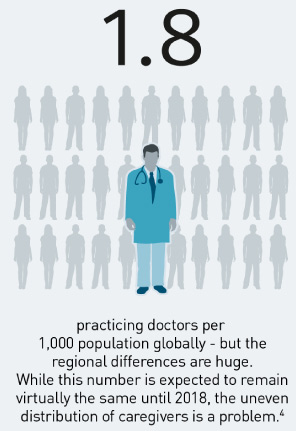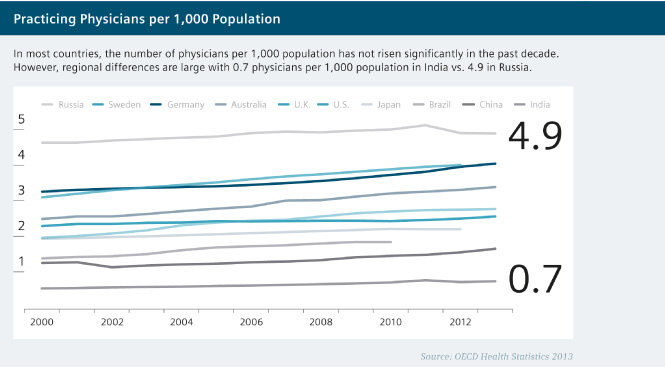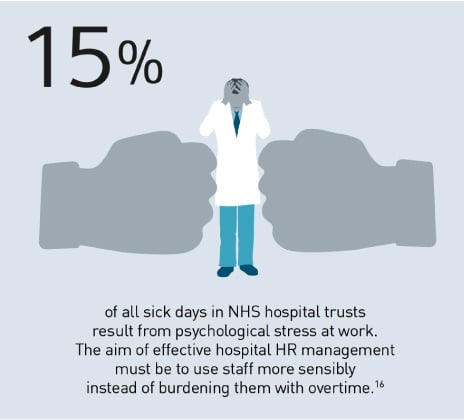HealthManagement, Volume 16 - Issue 4, 2016
Needs, Challenges, and Opportunities in Recruiting and Retaining Medical Professionals
Developed and developing countries alike struggle to supply adequate numbers of trained, qualified healthcare professionals, especially physicians and nurses. Sourcing, attracting, and retaining experienced employees are therefore among the biggest management challenges globally.1
 Staff Shortages
Worldwide
Staff Shortages
Worldwide
Unemployment is a rare phenomenon in the healthcare sector. In Germany, for example, the unemployment rate is only about 0.7 percent for nurses and 1 percent for doctors. A similar situation exists in the U.S., with an unemployment rate of 0.8 percent among doctors.2 The demand for nurses in the U.S. is estimated to increase by 26 percent by 2020.3 So where does the staffing challenge lie?
Firstly, most countries have been experiencing personnel shortages for many years. Secondly, the world population has grown by approximately 1.2 billion since 2000 – an increase of 20 percent in just 15 years.1 Globally, there are 1.8 doctors per 1,000 population.4 Thirdly, longer life expectancy is increasing the average age of patients, leading to higher medical care costs per patient. Finally, there is an uneven distribution of caregivers. This shortage of qualified professionals is one of the key challenges for the industry.1
Political Support
Governments around the world have recognized and are responding to the enormous HR challenges facing their healthcare systems. In many countries, governments directly influence the level and structure of physician remuneration because they are a key employer of physicians, purchase services, or regulate their fees.5 China has taken action to speed up caregiver training in response to the needs of its rapidly aging population. The country has also set a target to train six million caregivers by the end of 2020. In Brazil, the government has introduced a program to hire local and foreign doctors to work in poor and remote areas where there are shortages. By mid-2014, approximately 15,000 new clinicians had enrolled, more than three-quarters of whom came from Cuba.6
In response to shortages of doctors, some countries have developed more advanced roles for nurses. Evaluations of nurse practitioners from the U.S., Canada, and the U.K. show that advanced practice nurses can improve access to services and reduce waiting times while delivering the same quality of care as doctors to a range of patients.5 However, there are shortages of nurses as well as doctors, and nurses greatly outnumber physicians in most OE CD countries.5 The Royal College of Nursing in the U.K. estimates that there are 20,000 unfilled nursing posts across the country. The Center for Workforce Intelligence forecasts a shortfall of 47,000 nurses in the next few years.7

Increasing Workforce Productivity
In the past, hospitals have often made the mistake of requiring doctors and nurses to do more in less time. The consequence of this is high staff churn, a high level of absenteeism, and low overall employee satisfaction. In Germany, no other occupational group has more sick days than health professionals (4.5 percent).8 According to a study by Germany’s largest statutory health insurance company AO K, nurses have the most burnout-related sick days of any occupational group.9 According to a British study, 15 percent of all sick days in NHS hospital trusts result from psychological stress at work.10 The aim of effective hospital HR management must therefore be to use staff more sensibly instead of burdening them with overtime.
Automation, for instance, reduces the manual workload involved in setting up or evaluating clinical protocols. In addition, targeted training enables a more flexible use of staff – a key aspect of business management. The flexible deployment of staff also increases employee satisfaction, as their tasks become more varied. Doctors and nurses spend less time on unpopular administrative tasks, which reduces loss of information and frictional losses. If individual employees do fall sick, their work can be easily delegated to other employees thanks to the greater versatility of the staff. Additionally, modern information management is crucial for the speed and accuracy of care decisions by hospital staff. This is also an important factor in higher employee satisfaction.
Employee Satisfaction Lowers Costs
When a hospital’s reputation improves, its costs for attracting and retaining qualified personnel fall. In the U.K. for instance, the reputation of an NHS trust as an employer is the first consideration for one in five nurses when looking for a new job. Other important factors include a healthy work-life balance, good career prospects, and salary.11 As a result, hospital operators now optimize their clinical and administrative processes. They modernize their compensation and working time models, improve the promotion of education and scientific research, and create a corporate culture that makes them an employer of choice for scarce professionals.12

A good working relationship with colleagues is also a prerequisite for high employee satisfaction. In the healthcare sector in particular, effective communication and appropriate information exchange between work shifts are essential components of the job.13 Thus, m odern, user-friendly IT solutions that help staff efficiently share information across departments are key to job satisfaction. Additionally, there is a great desire and need for the systematic provision of further training measures. Besides preventing potentially costly errors, training promotes personal development, a more needs-based use of equipment, and the greatest possible flexibility in deploying staff. Job satisfaction is also based on making informed decisions based on one’s own knowledge and reliable information.
The Gender Factor
In the quest for well-qualified staff, female medical personnel play a key role, and their numbers are rising. In 2011, an average of 44 percent of doctors across OE CD countries were women. Since 2000, the proportion of female physicians has increased in all OE CD countries for which data is available.5 This trend is continuing, giving hospital managers more reason to specifically address the needs of the growing number of female doctors and nurses – such as flexible working hours, compressed work schedules, and fully paid maternity leave.
Naturally, such criteria differ from country to country. For example, fully paid maternity leave is mandated by law in countries such as Spain and Germany. In these countries, maternity leave therefore does not act as a differentiator in employer branding. In the U.S., however, these female-friendly criteria set top-rated U.S. companies apart from others.14
In a Nutshell
Workforce Challenges in Healthcare
- Given the tight labor market in the healthcare industry
and the challenge of retaining and attracting skilled professionals, it is
crucial for healthcare providers to foster their reputation as good employers
by offering professional development, sound education, and an efficient work
environment. This is true for medical personnel as well as for hospital
managers with future-proof leadership skills and a high degree of willingness
to change.
- Hospitals need to establish new work models in order to
increase efficiency and workforce satisfaction. Relevant measures do not
mutually contradict but rather encourage each other, and they should always be planned
and implemented holistically. Measures that systematically reduce e.g. overwork
to counteract the industry’s high rates of absenteeism and staff turnover also
play an important role.
- Quick and comprehensive access to relevant patient data
also determines the efficiency of a hospital workforce. In addition to full
availability, the needs-based processing/presentation of data is especially
important; therefore, information management is crucial for the speed and
accuracy of care decisions by hospital staff.
- The feminization of the medical profession is a worldwide
phenomenon. In order to become an attractive employer, hospital operators must
adapt to the specific needs of their female workforce to take advantage of
their increasingly important role.
- The flexible deployment of personnel is mainly relevant
from a business management point of view. It allows for optimizing schedules
and a more varied work environment for employees. However, it requires
establishing the right conditions in processes, skills management, and
technology
References:
- Deloitte, 2015 Global health care outlook
- Statista, Branchenreport 2015 Gesundheitswesen, Bureau of
Labor Statistics
- Manuel Dayrit, Brain Drain and Brain Gain: Selected Country
Experiences and Resources, 2013; US Department of Labor, 2012
- Economist Intelligence Unit Database, Losing Ground: Physician Income, CNN Health,World Bank
- OECD, Health at a Glance, 2013
- OECD 2007, www.worldhealthsummit.org
- TMP, Nursing a Healthy Reputation, 2014; www.tmpw.co.uk
- DAK 2014 / www.statista.com, Krankenstandswerte nach Wirtschaftsgruppen
- WIDO 2011, www.statista.com
- Conservatives for Liberty, Sickness absence across NHS hospital Trusts in England,2013-2014
- The Guardian, www.theguardian.com
- American Hospital Association, Workforce 2015
- Goldin C., A Grand Gender Convergence: Its Last Chapter. American Economic Review. 2014
- 2014 Working Mother 100 Best Companies; www.workingmother.com
- OECD, Health at a Glance, 2015
- The Guardian, www.theguardian.com

